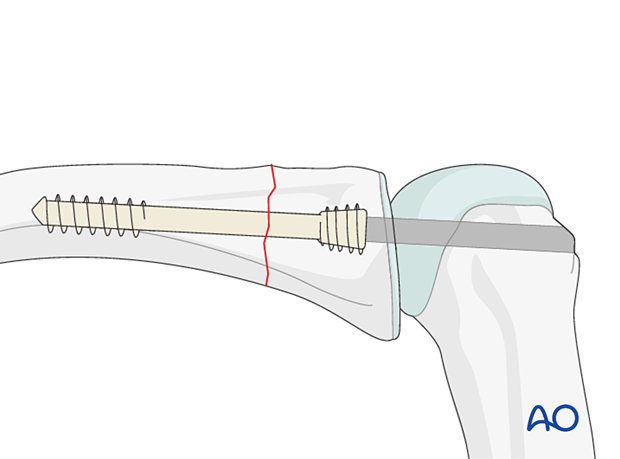Intramedullary screw fixation
1. General considerations
Introduction
Transverse extraarticular base fractures may be fixed with an intramedullary headless screw (2.4 or 3.0 mm) in an antegrade fashion.
This screw acts like an intramedullary nail.
The proximal fragment should be at least 6 mm long to hold the head of the screw.

The transarticular technique guides the screw through the metacarpal head into the proximal phalanx. The intraarticular technique guides the screw through the joint into the base of the proximal phalanx.
The transarticular technique is clearly destructive of the load-bearing cartilage of the distal end of the metacarpal. Since the screw cannot be readily removed, this technique should be reserved for highly selected fractures in which the functional outcome is likely to be optimal when applied by the expert surgeon.
For further reading on intramedullary screw fixation of proximal phalangeal fractures, see the dedicated section in:

Prerequisites for intramedullary screw fixation
To allow the screw head to be fully buried in the subchondral bone, the fracture line should be at least 6 mm away from the joint surface.
The diameter at the isthmus of the intramedullary canal should be at least 3 mm wide in AP and lateral views.
To allow for fracture compression, the length of the screw should be long enough so that the threads at the tip only engage in the far fragment.
To achieve optimal stabilization, the screw should be long enough and with a diameter filling the intramedullary canal.

2. Patient preparation
Place the patient supine with the arm on a radiolucent hand table.

3. Reduction
Manually correct any malrotation with the metacarpophalangeal (MCP) and proximal interphalangeal (PIP) joints fully flexed.
Confirm correct rotational alignment.
If closed reduction is not successful or in a nonacute case, proceed with an open reduction and consider another fixation technique.
When indirect reduction is not possible, this is usually due to interposition of parts of the extensor apparatus.

4. Checking alignment
Identifying malrotation
At this stage, it is advisable to check the alignment and rotational correction by moving the finger through a range of motion.
Rotational alignment can only be judged with flexed metacarpophalangeal (MCP) joints. The fingertips should all point to the scaphoid.
Malrotation may manifest by an overlap of the flexed finger over its neighbor. Subtle rotational malalignments can often be judged by a tilt of the leading edge of the fingernail when the fingers are viewed end-on.
If the patient is conscious and the regional anesthesia still allows active movement, the patient can be asked to extend and flex the finger.
Any malrotation is corrected by direct manipulation and later fixed.

Using the tenodesis effect when under anesthesia
Under general anesthesia, the tenodesis effect is used, with the surgeon fully flexing the wrist to produce extension of the fingers and fully extending the wrist to cause flexion of the fingers.

Alternatively, the surgeon can exert pressure against the muscle bellies of the proximal forearm to cause passive flexion of the fingers.

Confirm fracture fixation and stability with an image intensifier.
5. Intraarticular screw insertion
Entry point
The entry point for antegrade insertion is positioned slightly dorsal and either radial or ulnar.

Guide-wire insertion
Hold the MCP joint in 60° flexion.
Insert the guide wire dorsally into the medullary canal through the MCP joint parallel to the extensor tendon under image intensification.
Confirm correct rotational alignment.

Screw insertion
Perform a small incision around the guide wire. This will protect the soft tissues during screw insertion.

Select a screw with the appropriate diameter and length using the depth gauge provided. The thread of the tip should engage the isthmus distal to the fracture line.
Insert the screw over the guide wire until the head is subchondral and the fracture is compressed.

6. Transarticular screw insertion
Guide-wire insertion
Hold the MCP joint in 90° flexion.
While retracting the extensor tendon laterally, insert the guide wire dorsally in the metacarpal head, through the MCP joint, and into the medullary canal of the proximal phalanx under image intensification.
Confirm correct rotational alignment.

Screw insertion
Perform a small incision around the guide wire and split the extensor tendon longitudinally. This will protect the soft tissues during screw insertion.

Select a screw with the appropriate diameter and length using the depth gauge provided. The thread of the tip should engage the isthmus distal to the fracture line.
Insert the screw over the guide wire until the head is fully entered into the proximal phalangeal base and the fracture is compressed.

7. Final assessment
Confirm reduction and correct screw placement with an image intensifier.
8. Aftercare
Postoperative phases
The aftercare can be divided into four phases of healing:
- Inflammatory phase (week 1–3)
- Early repair phase (week 4–6)
- Late repair and early tissue remodeling phase (week 7–12)
- Remodeling and reintegration phase (week 13 onwards)
Full details on each phase can be found here.
Postoperative treatment
If there is swelling, the hand is supported with a dorsal splint for a week. This would allow for finger movement and help with pain and edema control. The arm should be actively elevated to help reduce the swelling.
The hand should be splinted in an intrinsic plus (Edinburgh) position:
- Neutral wrist position or up to 15° extension
- MCP joint in 90° flexion
- PIP joint in extension

The reason for splinting the MCP joint in flexion is to maintain its collateral ligament at maximal length, avoiding scar contraction.
PIP joint extension in this position also maintains the length of the volar plate.

After subsided swelling, protect the digit with buddy strapping to a neighboring finger to neutralize lateral forces on the finger.

Functional exercises
To prevent joint stiffness, the patient should be instructed to begin active motion (flexion and extension) immediately after surgery.

Follow-up
See the patient after 5 and 10 days of surgery.
Implant removal
Intramedullary screws should not be removed as this may result in cartilage damage.












